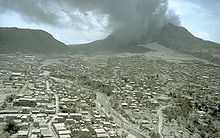Plymouth, Montserrat
Coordinates: 16°42′23″N 62°12′57″W / 16.706417°N 62.215839°W
| Plymouth | |
|---|---|
| Ghost town | |
 | |
 | |
| Country | United Kingdom |
| Overseas territory | Montserrat |
| Population (2007) | |
| • Total | 0 (City completely evacuated due to volcanic eruption) |
| Time zone | Atlantic (UTC-4) |
Plymouth was the capital of the island of Montserrat, an overseas territory of the United Kingdom located in the Leeward Island chain of the Lesser Antilles, West Indies. The town was overwhelmed by volcanic eruptions starting in the 1990s and was abandoned. For centuries it had been the only port of entry to the island.
History
Volcano and abandonment


Beginning in July 1995, a series of huge eruptions at the Soufrière Hills volcano sent pyroclastic flows and ash falls across a wide area of southern Montserrat, including Plymouth. It was immediately clear that the city was in danger; on 21 August 1995, tephra fell on Plymouth, and in December residents were evacuated as a precaution. Residents were allowed back a few months later, but on 25 June 1997, a massive eruption produced pyroclastic surges that killed 19 people and reached nearly to the island's airport on the eastern side of the island. Plymouth was again evacuated.
Between 4–8 August a further series of eruptions destroyed approximately 80% of the city, burying it under 1.4 metres (4.6 ft) of ash. This hot material burned many of the buildings, making inhabitation nearly impossible for a sizable portion of the residents.
The pyroclastic flows, lava, ash and other volcanic rock types were mostly compact, having a density similar to that of concrete. The removal of the overburden would have required the use of explosives, bulldozers and other resources too expensive for widespread use. Furthermore, it was anticipated that the soil underneath the hardened mud and lava would have been scorched and left completely non-arable by the heat of the pyroclastic flows.[1] Plymouth was abandoned and the southern half of the island was declared an "exclusion zone" because of the continuing activity at the Soufrière Hills. The government of the island was moved to Brades, although Plymouth remains the de jure capital. As of 2013, a new port and capital are under construction at Little Bay, on the island's northwest coast.
The destruction of Plymouth caused severe problems for the island of Montserrat. Plymouth had been by far the largest settlement on the island, with around 4,000 inhabitants. It had been the site of almost all the island's shops and services, in addition to having been its seat of government. Some of the lost facilities were subsequently re-built elsewhere on Montserrat, but this did not prevent emigration. More than two-thirds of the island's population was evacuated overseas, and most of the people who left have not returned.[citation needed]
Geography
Climate
| Climate data for Plymouth | |||||||||||||
|---|---|---|---|---|---|---|---|---|---|---|---|---|---|
| Month | Jan | Feb | Mar | Apr | May | Jun | Jul | Aug | Sep | Oct | Nov | Dec | Year |
| Record high °C (°F) | 32 (90) |
33 (91) |
34 (93) |
34 (93) |
36 (97) |
37 (99) |
37 (99) |
37 (99) |
36 (97) |
34 (93) |
37 (99) |
33 (91) |
37 (99) |
| Average high °C (°F) | 29 (84) |
30 (86) |
31 (88) |
31 (88) |
32 (90) |
32 (90) |
33 (91) |
33 (91) |
32 (90) |
31 (88) |
30 (86) |
29 (84) |
31.1 (88) |
| Average low °C (°F) | 23 (73) |
23 (73) |
24 (75) |
24 (75) |
24 (75) |
25 (77) |
25 (77) |
25 (77) |
24 (75) |
24 (75) |
24 (75) |
23 (73) |
24 (75) |
| Record low °C (°F) | 17 (63) |
18 (64) |
18 (64) |
18 (64) |
19 (66) |
21 (70) |
22 (72) |
22 (72) |
21 (70) |
19 (66) |
19 (66) |
18 (64) |
17 (63) |
| Precipitation mm (inches) | 122 (4.8) |
86 (3.39) |
112 (4.41) |
89 (3.5) |
97 (3.82) |
112 (4.41) |
155 (6.1) |
183 (7.2) |
168 (6.61) |
196 (7.72) |
180 (7.09) |
140 (5.51) |
1,640 (64.57) |
| Source: BBC Weather [2] | |||||||||||||
See also
- List of settlements abandoned after the 1997 Soufrière Hills eruption
References
- ↑ The difficulty of exhuming a smothered urban centre is illustrated by the history of the extinct towns of Pompeii and Herculaneum, which were buried by pyroclastic flows and volcanic ash under circumstances similar to those that pertained at Plymouth. Archeological excavation at the Roman sites continues after centuries and may never be completed.
- ↑ "Average Conditions Plymouth, Montserrat". BBC Weather. Retrieved 14 July 2010.
External links
| Wikimedia Commons has media related to Plymouth. |
| |||||||||||||||||